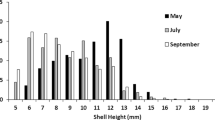Abstract
The biology and host specificity of the seed-feeding bruchids,Acanthoscelides quadridentatus (Schaeffer) andA. puniceus Johnson, from Mexico were studied in quarantine facilities in Australia. Distinguishing characters in the genitalia of each species are illustrated. Oviposition was recorded on 16 of 73 species of plants tested but larvae died without entering pods or seeds, except onMimosa invisa K. F. P. von Martius andM. pigra L. Larvae entering seeds ofM. invisa died in the first instar. The bruchids were clearly specific toM. pigra and were subsequently released as part of a program for biological control of this weed in the Northern Territory, Australia in April 1983 and thailand in July 1984.
Résumé
La biologie et la spécificité vis-à-vis de l'hôte des Bruches se nourrissant de graines,Acanthoscelides quadridentatus (Schaeffer) etA. puniceus Johnson, en provenance du Mexique ont été étudiées dans l'unité de quarantaine en Australie. Les caractères distinctifs des génitalia de chacune des espèces sont illustrés. La ponte était observée sur 16 des 73 espèces de plantes testées, mais les larves mouraient sans pénétrer dans les gousses ou les graines, excepté surMimosa invisa K. F. P. Von Martins etM. pigra L. les larves ayant pénétré dans les graines deM. invisa mouraient au 1er stade. Les bruchides étaient spécifiques deM. pigra et furent en conséquence lâchés comme partie d'un programme de lutte biologique contre cette mauvaise herbe dans la partie nord de l'Australie en Avril 1983 et en Thaïlande en juillet 1984.
Similar content being viewed by others
References
Annis, B. &O'Keeffe, L. E. — 1984. Effect of pollen source on oogenesis in the pea weevil,Bruchus pisorum L. [Coleoptera: Bruchidae]. —Prot. Ecol., 6, 257–266.
Hopkins, M. J. G. — 1984. The seed beetles [Bruchidae] ofParkia [Leguminosae: Mimosoideae] in Brazil: strategies of attack. In: Tropical Rain-Forest: The Leeds Symposium, (A. C. Chadwick &S. L. Sutton, eds). —Leeds Philosophical and Literary Society, Leeds 1, England, pp. 139–145.
Janzen, D. H. — 1975. Interactions of seeds and their insect predators/parasitoids in a tropical deciduous forest. In: Evolutionary Strategies of Parasitic Insects and Mites, (P. W. Price, ed.) —Plenum Press, New York, USA, pp. 154–186.
Janzen, D. H. — 1980. Specificity of seed-attacking beetles in a Costa Rican deciduous forest. —J. Ecol., 68, 929–952.
Johnson, C. D. — 1981. Interactions between bruchid [Coleoptera] feeding guilds and behaviourial patterns of pods of the Leguminosae. —Environ. Entomol., 10, 249–253.
Johnson, C. D. — 1983. Ecosystematics ofAcanthoscelides [Coleoptera, Bruchidae] of Southern Mexico and Central America. —Misc. Publ. Entomol. Soc. Am., 56, 167–168 & 172–175.
Kingsolver, J. M. — 1980. Thequadridentatus group ofAcanthoscelides descriptions of three new species, notes, synonymies, and a new name [Coleoptera, Bruchidae]. —Brenesia, 17, 281–294.
Lonsdale, W. M. &Segura, R. — 1987. A demographic comparison of native and introduced populations ofMimosa pigra. In: Proceedings of the 8th Australian Weeds Conference, Sydney, (D. Lemerle &A. R. Leys, eds). —Weed Soc. of New South Wales, Sydney, Australia, pp. 163–166.
Miller, I. L. — 1982. The distribution and threat ofMimosa pigra in Australia. In: Proceedings of an international symposium.Mimosa pigra Management, Chiang Mai, Thailand, 1982 (G. Lamar Robert &D. H. Habeck, eds). —Int. Plant Prot. Centre, Corvallis, Oregon, USA, pp. 38–50.
Miller, I. L., Nemestothy, L. &Pickering, S. E. — 1981.Mimosa pigra in the Northern Territory. —Tech. Bull., 51, Dept. Primary Production, Northern Territory, Australia.
Napompeth, B. — 1982. Background, threat, and distribution ofMimosa pigra L. in Thailand. In: Proceedings of an international symposium.mimosa pigra Management, Chiang Mai, Thailand, 1982. (G. Lamar Robert &D. H. Habeck, eds). —Int. Plant Prot. Centre, Corvallis, Oregon, USA, pp. 15–26.
Southgate, B. J. — 1979. Biology of the Bruchidae. —Annu. Rev. Entomol., 24, 449–473.
Author information
Authors and Affiliations
Rights and permissions
About this article
Cite this article
Kassulke, R.C., Harley, K.L.S. & Maynard, G.V. Host specificity ofAcanthoscelides quadridentatus andA. Puniceus [Col.: Bruchidae] for biological control ofMimosa pigra (with preliminary data on their biology). Entomophaga 35, 85–97 (1990). https://doi.org/10.1007/BF02374305
Received:
Accepted:
Issue Date:
DOI: https://doi.org/10.1007/BF02374305
Key-Words
- Bruchidae
- Acanthoscelides quadridentatus
- A. puniceus
- Mimosa pigra
- biology
- host specificity
- biological control




